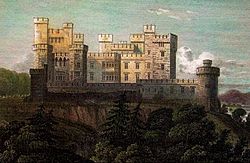Mitchelstown Castle
| Mitchelstown Castle | |
|---|---|

19th-century painting of the former castle
|
|
| Location | Mitchelstown, County Cork, Ireland. |
| Coordinates | 52°16′20″N 08°16′48″W / 52.27222°N 8.28000°WCoordinates: 52°16′20″N 08°16′48″W / 52.27222°N 8.28000°W |
| Built | 19th century |
| Built for | 3rd Earl of Kingston |
| Demolished | 1920's |
| Architect | James and George Pain. |
Mitchelstown Castle, the former home of the Irish Earls of Kingston, was located in the north County Cork town of Mitchelstown in Ireland.
White Knights, Dark Earls is to date the most extensive published account of Mitchelstown Castle, which was the biggest neo-Gothic house in Ireland. A castle was first built at Mitchelstown in the 15th century by the White Knights of Mitchelstown, from whom, through marriage, it passed to the King family, Barons and Earls of Kingston. James, 4th Baron Kingston, extensively refurbished and modernised the castle in the 1730s. After his death in 1761, the castle passed to his granddaughter, Caroline Fitzgerald. She married her cousin Robert King, Viscount Kingsborough, who was, from 1797, the 2nd Earl of Kingston. The Kingsboroughs demolished most of the old Mitchelstown Castle in the 1770s and incorporated what remained into a new Palladian mansion, described as a 'house with wings'.
In 1823, after his succession, their son, George, 3rd Earl of Kingston, demolished the Palladian house and replaced it with a new castle designed by James and George Richard Pain. It had 60 principal and 20 minor bedrooms, a 100-foot-long (30 m) gallery, three libraries, morning room, dining room (which could seat 100 guests at one sitting) and various other facilities.
Mitchelstown Castle was the biggest neo-Gothic house in Ireland, cost £100,000 to build and became the 'fashion statement' of its time. It inspired other major Irish castles, such as Strancally Castle (County Waterford) and Dromoland Castle for Lord Inchiquin.
The 100,000-acre Mitchelstown estate ran into considerable financial difficulties, which, after the Great Famine of 1845–51, forced its owners to sell 70,000 acres (280 km2) in the Landed Estates Court. Further difficulties arose as a result of internal family squabbling, legal disputes and the Land War of the 1880s, in which the estate played a prominent part.
...
Wikipedia

